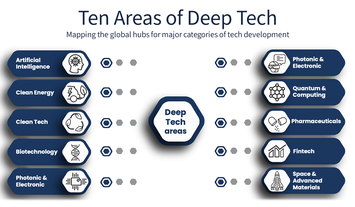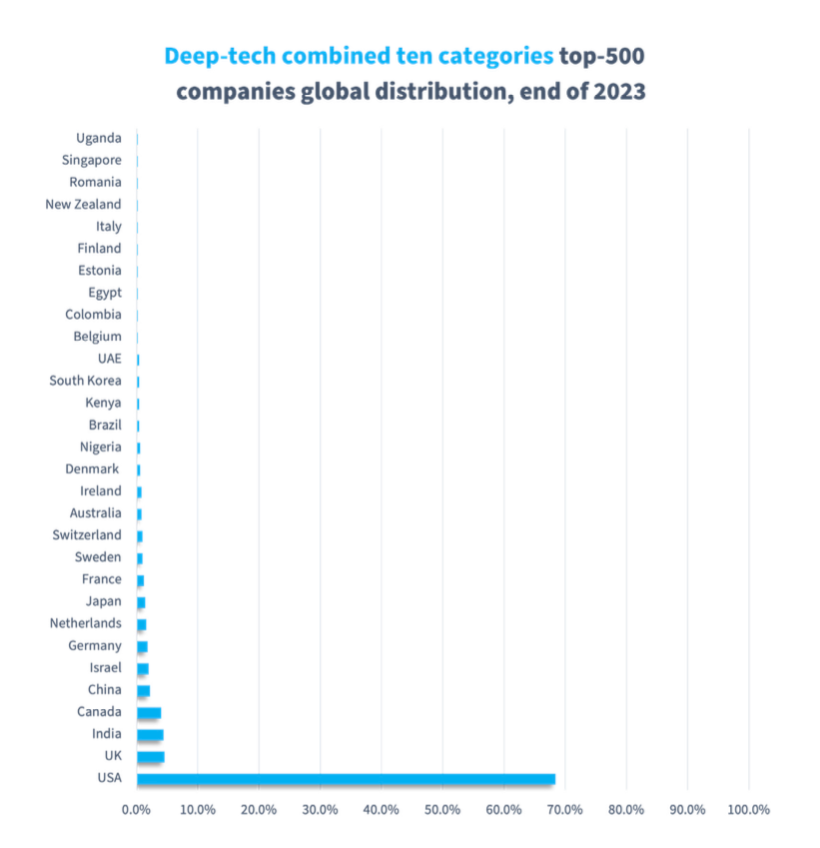
During the 20th century global prosperity was focused to where technological development was happening, and this has also been the pattern for the initial decades of the 21st century. The development of deep technologies, in various areas, continues to be a good predictor for future progress. In order to better understand where the future growth is happening, ECEPR is with support from Nordic Capital launching the first Deep Tech Index. In this new study, one of the first of its kind, we map out where the top 500 companies in ten areas of deep tech are located.
A key finding is that fully 72 percent of the leading deep tech companies are based in North America, 68 percent in the US alone. This compares with 14 percent in Europe, 11 percent in Asia. Africa, Oceania, and Latin America each host around one per cent of the leading deep tech firms. Santa Clara Valley, or Silicon Valley, is the leading deep tech hub globally. About 24 per cent of all the leading technology firms reside here. Thomas Edison founded the world’s first industrial innovation laboratory in this valley 150 years ago, and it has since become the most significant region for development of novel technologies.
The second most important global hub for deep tech is New York, where close to 8 percent of all globally leading deep tech companies are located. Boston and Los Angeles are other important hubs. Outside the US, the leading hubs are London, Tel Aviv, New Delhi, Toronto, Paris, Tokyo, Bengaluru, Amsterdam, Berlin, Stockholm, Montreal, and Dublin.
North America has particularly strong dominance in the areas of quantum & computing, as well as in pharmaceuticals and artificial intelligence. In these three deep-tech fields, four out of five or more of the leading global firms are in North America, predominantly the USA. Quantum & computing includes those companies that work on new quantum computers, as well as traditional computer technology. In this field, 44 out of the 50 leading global companies are found in the USA, and additionally one in Canada, which means that fully 90 percent are in North America. The Santa Clara Valley alone has a majority of 26 out of the 50 leading companies in quantum & computing.
In the field of pharmaceuticals, 41 out of the 50 leading global companies are found in the USA, and additionally a couple in Canada, which means that 86 percent are localized in North America. The Boston urban region has fully 13 out of these companies, with a further seven in New York, three in Santa Clara Valley, and three more in San Diego.
The third field with a particularly strong presence for North America is artificial intelligence. In this deep-tech field, 37 out of the globally leading 50 companies are localized in the USA and a further 3 in Canada. Thus, 80 percent of the leading companies are found in North America. Most of the leading artificial intelligence companies are found in the Santa Clara Valley, 27 out of 50, with New York hosting additionally three.
| Quantum & Computing | Pharmaceuticals | Artificial Intelligence | |||||
| North America | 90% | North America | 86% | North America | 80% | ||
| Europe | 4% | Europe | 8% | Europe | 10% | ||
| Asia | 6% | Asia | 6% | Asia | 10% | ||
| Rest of world | 0% | Rest of world | 0% | Rest of world | 0% | ||
In fact, in all deep-tech areas except Clean Tech, more than half of the leading top-50 firms of each field is located in the USA. Canada is however strong in Clean Tech, why even in this area half of the globally leading deep-tech companies are located in North America. The share of North American deep-tech companies is lowest for Clean Tech (50%) and highest for quantum and computing (90%).

The challenge for the US going forwards is to retain this very dominating position. To achieve this, the US needs to stay at top in education and research. Currently, the nation is not fostering enough mathematical skills in the young generation. Since the early 2000s, US students have decreased their mathematics scores significantly in the global PISA study. Fully 34 percent of USA mathematics students are low-performing, while only 7 percent are high-performing. In both instances, the USA performs worse than the average of developed OECD countries.
The shortcomings have long been compensated for top talents from around the world flocking to American universities. While this does continue, increasingly other parts of the world are competing at the top of higher education and research. According to the QS World University Rankings, 27 out of the leading hundred engineering and technology universities are located in the US and Canada, less than 30 found in Europe, and 34 found in Asia. A boost in knowledge, alongside growth promoting economic policies, are needed for the US to retain the gold spot.
Nima Sanandaji, Director, European Centre for Entrepreneurship and Policy Reform (ECEPR)
Charts: courtesy Nima Sanandaji












